Turquía se estrenó en la máxima categoría del automovilismo en el año 2005. El Gran Premio turco empezó a correrse en el circuito del Istanbul Park, ubicado cerca de la capital de este país. Es un circuito bastante peculiar, se hizo famoso por cierta curva, que incluso otros circuitos posteriores han buscado copiar de alguna forma. analizaremos este circuito en esta publicación.
Turkey made its debut in the top category of motor racing in 2005. The Turkish Grand Prix started to be run at the Istanbul Park circuit, located near the capital of this country. It is a rather peculiar circuit, it became famous for a certain curve, which even later circuits have tried to copy in some way. We will analyze this circuit in this publication.
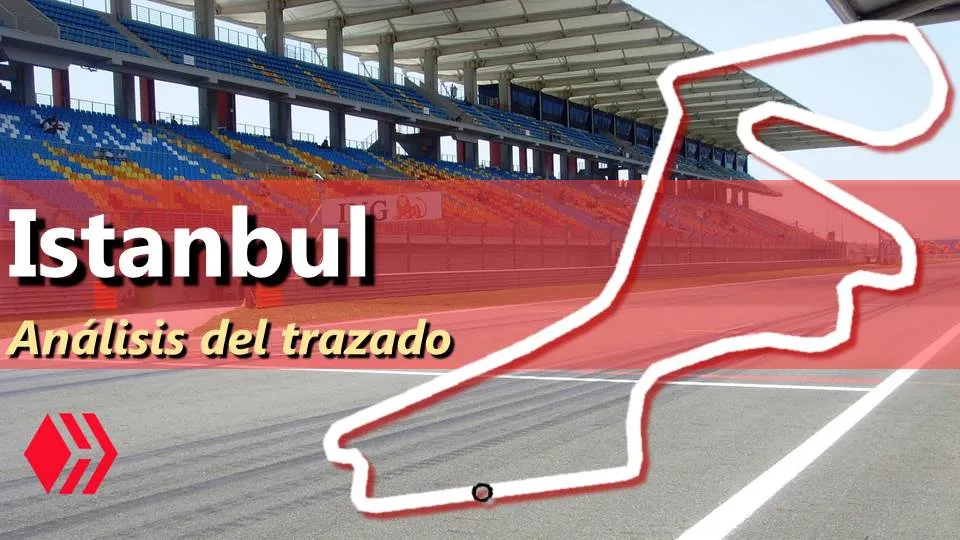
El pasado año 2020 ya habíamos abordado este circuito en la reseña de aquel Gran Premio, en esta publicación: La F1 vuelve a Turquía a lo grande. Allí se realiza un análisis de este circuito, sin embargo, quizás no con la profundidad de otras publicaciones de esta serie. Este circuito, como muchos otros, fue diseñado por el ingeniero alemán Hermann Tilke, y tal como lo reseñé anteriormente, es una de sus obras maestras.
Last year 2020 we had already addressed this circuit in the review of that Grand Prix, in this publication: F1 returns to Turkey in a big way. An analysis of this circuit is made there, however, perhaps not with the depth of other publications in this series. This circuit, like many others, was designed by German engineer Hermann Tilke, and as I reviewed earlier, it is one of his masterpieces.
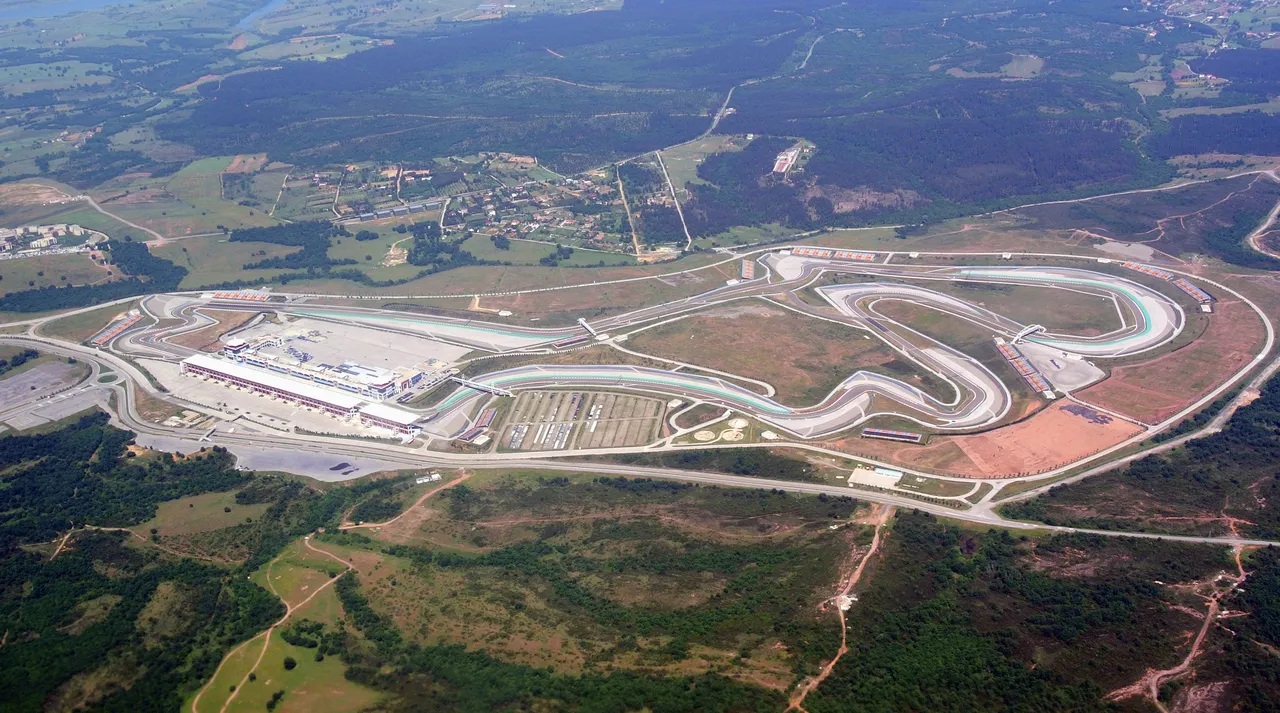
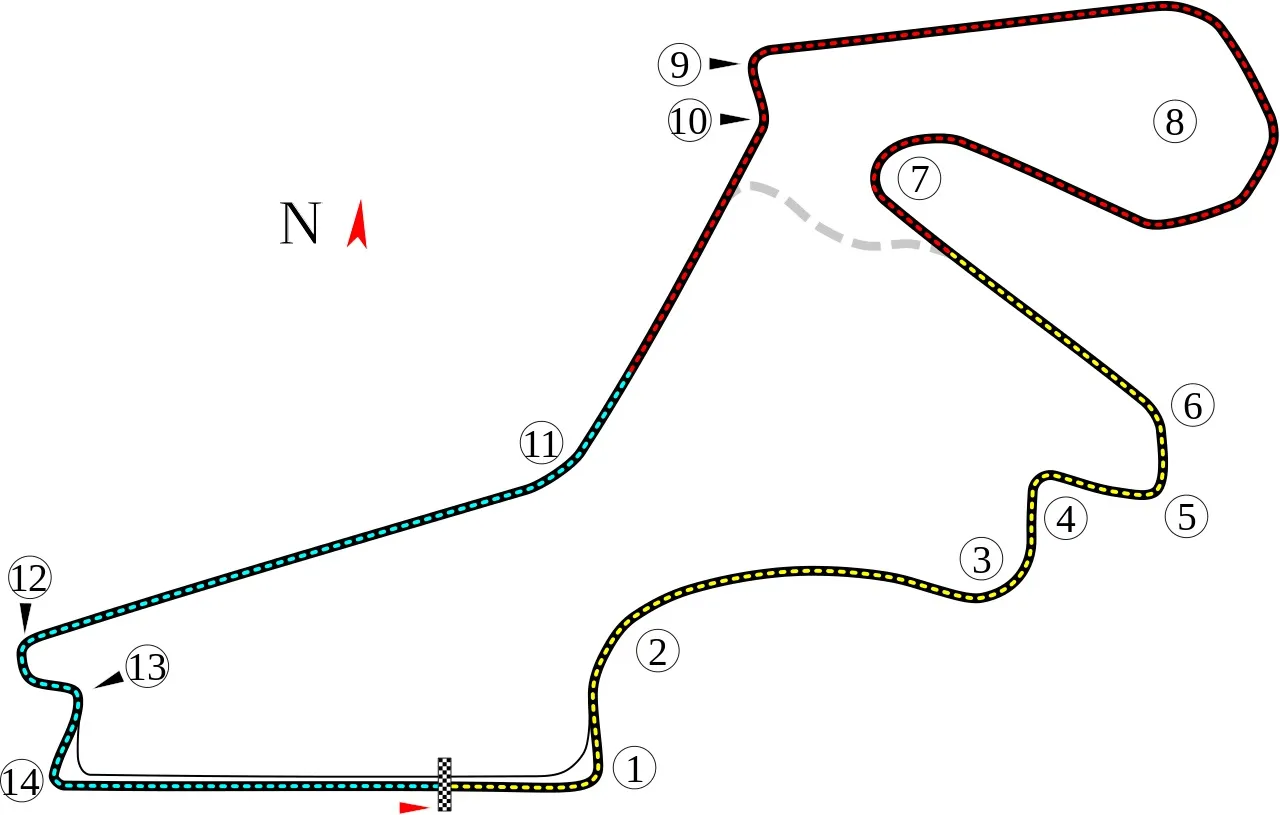
El circuito mide 5340 metros de longitud y posee 15 curvas. A pesar de ser un circuito moderno, construido en este siglo, guarda ciertas características presentes en algunos circuitos clásicos. Por otro lado, sus zonas más lentas y técnicas hacen que no olvidemos que es un circuito moderno. Se dejó de correr en este circuito luego del año 2011, por razones económicas. Pero ha vuelto con fuerza en 2020 y 2021, al protagonizar dos carreras excelentes.
The circuit is 5340 meters long and has 15 turns. In spite of being a modern circuit, built in this century, it keeps certain characteristics present in some classic circuits. On the other hand, its slower and technical areas make us not forget that it is a modern circuit. It was stopped racing on this circuit after 2011, for economic reasons. But it has come back with force in 2020 and 2021, by starring two excellent races.
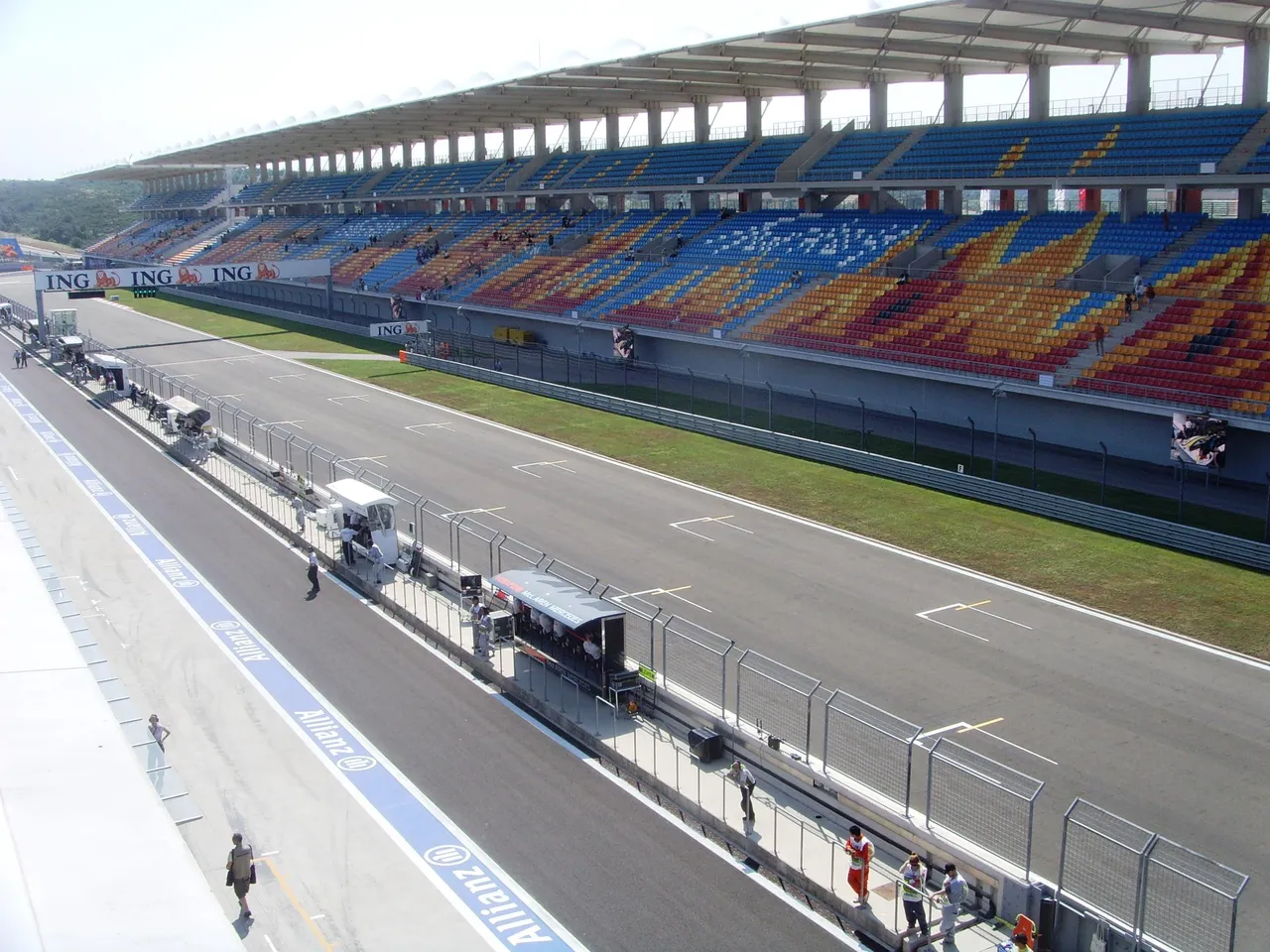
Es un circuito bastante singular, no solo por lo anteriormente dicho, sino porque se corre en sentido contrario a las agujas del reloj. Es difícil intentar comparar este circuito con otro, ya que no hay muchos que se le parezcan. En palabras de Tilke, este circuito fue diseñado para "sacar a los pilotos de pista". Esto lo podemos ver en distintas zonas del circuito, especialmente cuando la lluvia se hace presente.
It is a rather unique circuit, not only because of the above, but also because it is run in a counterclockwise direction. It is difficult to try to compare this circuit with any other, as there are not many that resemble it. In Tilke's words, this circuit was designed to "get the drivers off the track". This can be seen in different areas of the circuit, especially when rain is present.
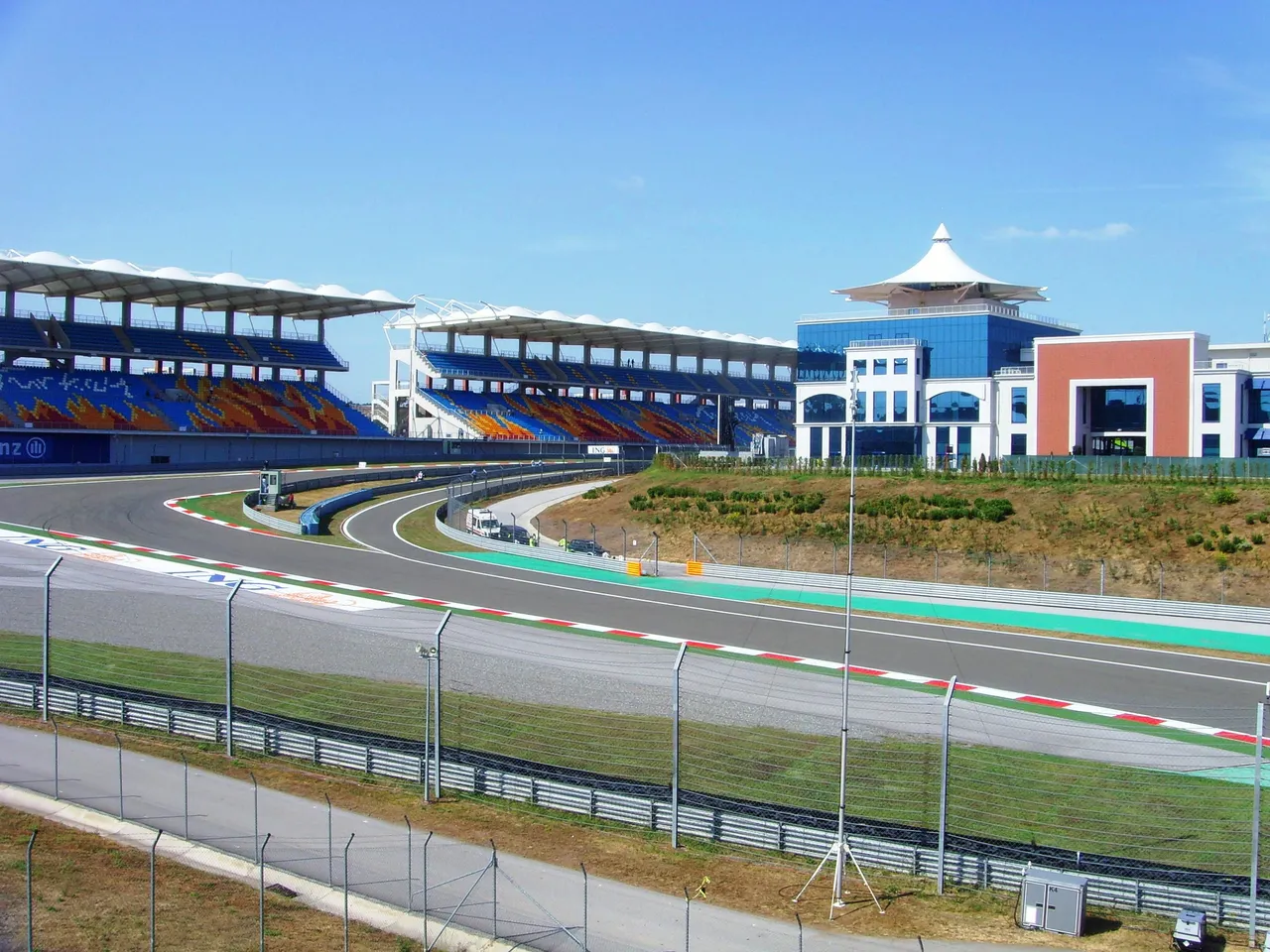
La primera y segunda curva constituyen una zona muy importante del circuito, ya que "impulsa" a los autos al resto del circuito con la mayor velocidad posible. Esto es algo muy similar a loa que sucede con la primera curva del circuito de Melbourne, en Australia. Este es una zona de muchas luchas por posiciones en pista, así como incidentes en la salida de la carrera. Los autos tratan de ajustar su línea de recorrido para salir con la mayor velocidad posible a la curva 2, la cual se traza a fondo (o casi a fondo), y en este proceso pueden suceder toques e incidentes.
The first and second turns are a very important part of the circuit, as they "push" the cars to the rest of the circuit with the highest possible speed. This is very similar to what happens with the first corner of the Melbourne circuit in Australia. This is an area of many fights for track positions, as well as incidents at the start of the race. The cars try to adjust their line of travel to exit with the highest possible speed to turn 2, which is drawn at full throttle (or almost full throttle), and in this process touches and incidents can happen.
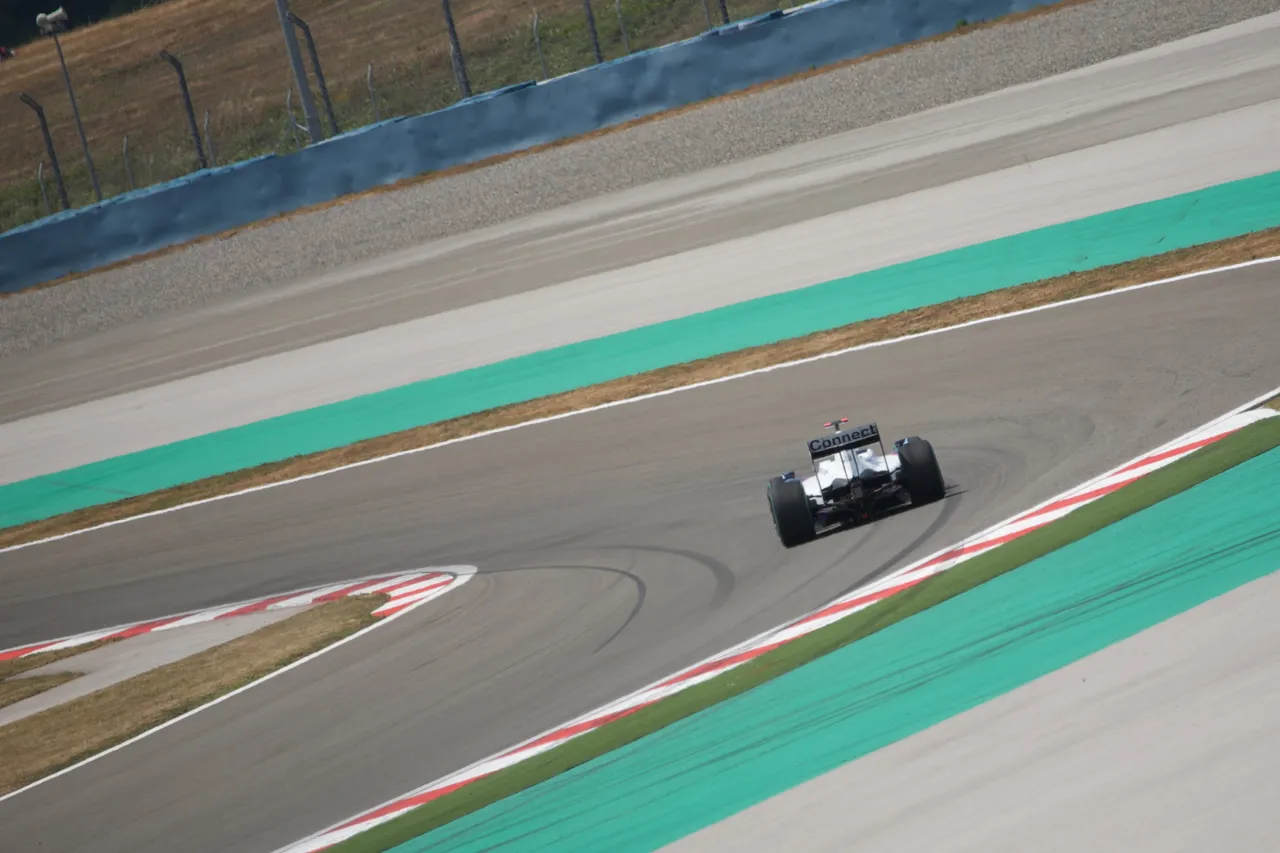
La "recta" entre las curvas 2 y 3 es bastante particular, ya que es curva en su totalidad. En lenguaje de automovilismo, se le suele decir "recta" a cualquier trazado que implique aceleración a fondo, por más que este no sea del todo recto. Esto es algo que puede tener un efecto interesante en las luchas por posiciones, especialmente tomando en cuenta las características de la curva 3.
The "straight" between turns 2 and 3 is quite particular, since it is curved in its entirety. In motorsport parlance, we usually say "straight" to any track that involves full throttle acceleration, even if it is not completely straight. This is something that can have an interesting effect on the fight for positions, especially taking into account the characteristics of Turn 3.

Los autos intentan salir con la mayor velocidad posible de la primera curva, y el que mejor haga esto, tiene distintas posibilidades en la curva 3 para adelantar: por fuera o por dentro. En mi opinión, la curva 3 es una de las más importantes de este circuito. Veamos su forma, implica un giro a la izquierda a velocidades relativamente altas. Y no solo eso, sino que inmediatamente al girar hay que frenar casi a fondo para tomar la complicada curva 4, cerrada y lenta. Esto permite varias posibilidades para adelantar: afuera por curva 3 y adentro en curva 4, o por dentro en curva 3 y afuera en curva 4.
The cars try to exit the first corner as fast as possible, and whoever does this best, has different possibilities in turn 3 to overtake: on the outside or on the inside. In my opinion, turn 3 is one of the most important turns of this circuit. Let's look at its shape, it involves a left turn at relatively high speeds. And not only that, but immediately after the turn you have to brake very hard in order to take the complicated turn 4, which is tight and slow. This allows several possibilities for overtaking: outside turn 3 and inside turn 4, or inside turn 3 and outside turn 4.
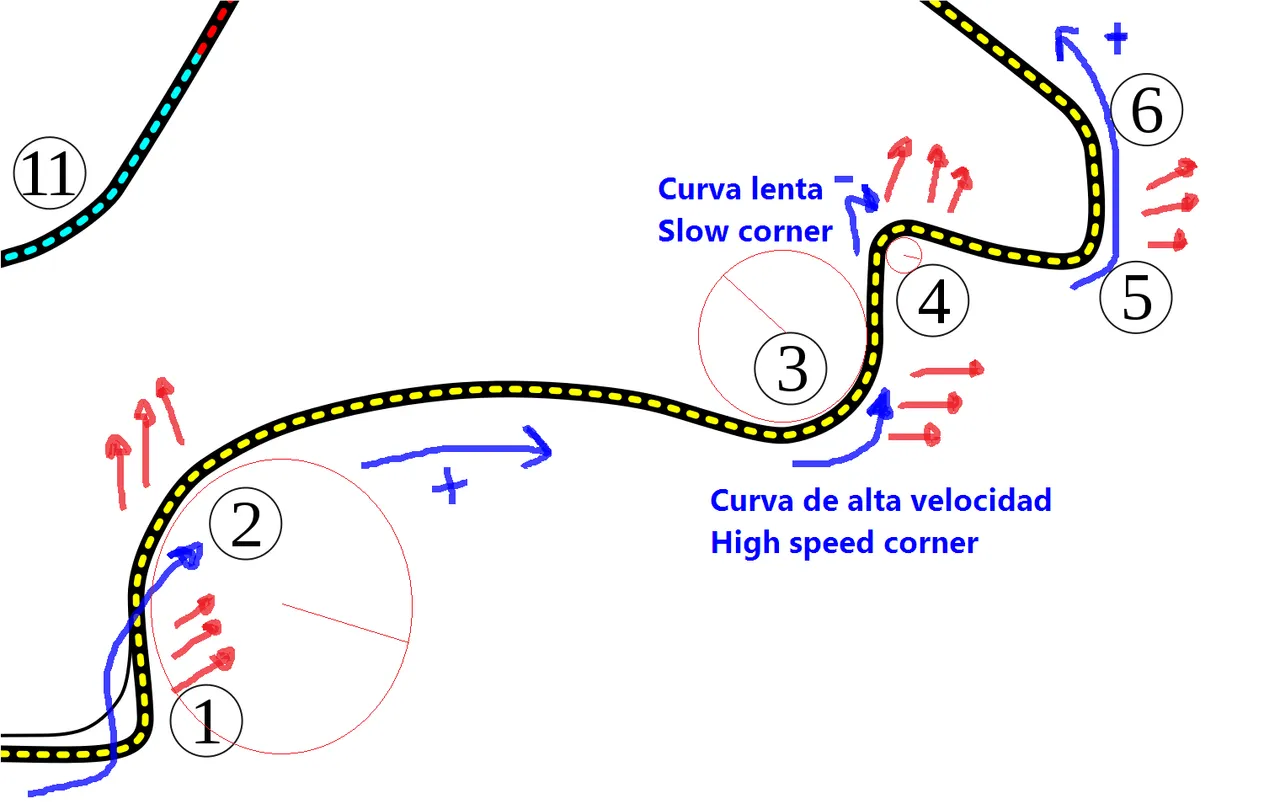
Todo esto corresponde a un primer sector del circuito que podría decirse que termina antes de llegar a la curva 7, ya que las curvas 5 y 6 son una especie de transición, donde vamos gradualmente acelerando para salir con la mayor velocidad posible. Al igual que las curvas anteriores estas curvas también intentar "sacar para afuera" a los pilotos que cometan un error o sean muy bruscos con el acelerador.
All this corresponds to a first sector of the circuit that could be said to end before reaching turn 7, since turns 5 and 6 are a kind of transition, where we gradually accelerate to get out with the highest possible speed. Like the previous curves, these curves also try to "take out" the pilots who make a mistake or are very abrupt with the accelerator.
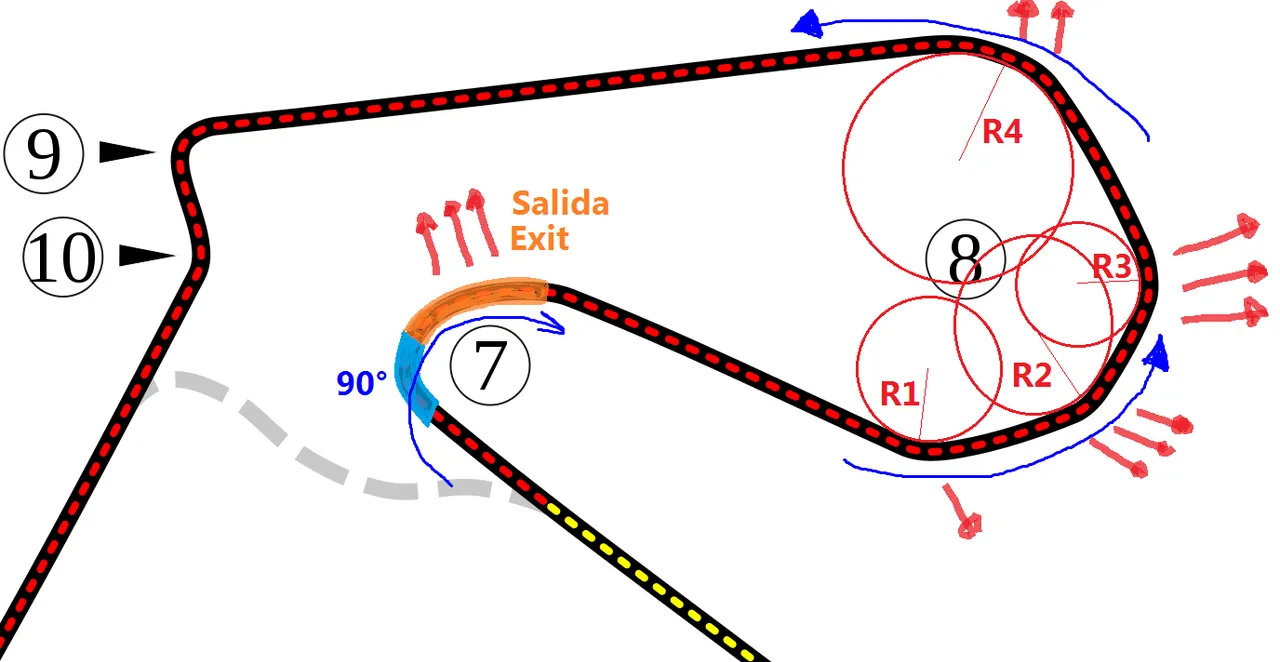
El siguiente sector empieza con una curva que podría parecer en forma de "U", pero en realidad es un poco más compleja de lo que parece. En realidad, la curva 7 es más una curva de 90° con una salida que se curva aún más hacia la derecha. Esto hace que los autos deban luchar contra la fuerza centrífuga que los empuja hacia afuera, y lograr acelerar gradualmente hacia la derecha de la forma más prolija. Esto es importante para llegar a la famosa curva 8 con la mayor velocidad posible.
The next sector starts with a curve that might look like a "U" shape, but is actually a bit more complex than it looks. In reality, Turn 7 is more of a 90° turn with an exit that curves even further to the right. This makes the cars have to fight against the centrifugal force pushing them to the outside, and manage to gradually accelerate to the right in the neatest way. This is important to reach the famous turn 8 with the highest possible speed.
La curva 8 en realidad es una composición de 4 curvas con 4 diferentes radios de giro. Los primeros dos suelen trazarse a fondo, mientras que el tercer radio de giro, el cual es el más cerrado de los 4, generalmente requiere una ligera reducción de velocidad para no salirse de pista o perder el control del auto. El último radio de giro es un poco más abierto y suave, y se traza a fondo para salir a la recta siguiente. Esta es la curva que más intenta "sacar" a los autos de pista (hacia el lado derecho), tal cual Tilke describe este circuito.
Turn 8 is actually a composition of 4 turns with 4 different turning radiuses. The first two are usually full throttle, while the third turn radius, which is the tightest of the 4, usually requires a slight reduction in speed so as not to run off the track or lose control of the car. The last turn radius is a little more open and smoother, and it is traced at full throttle to exit to the next straight. This is the corner that tries the most to "pull" the cars off the track (to the right side), as Tilke describes this circuit.
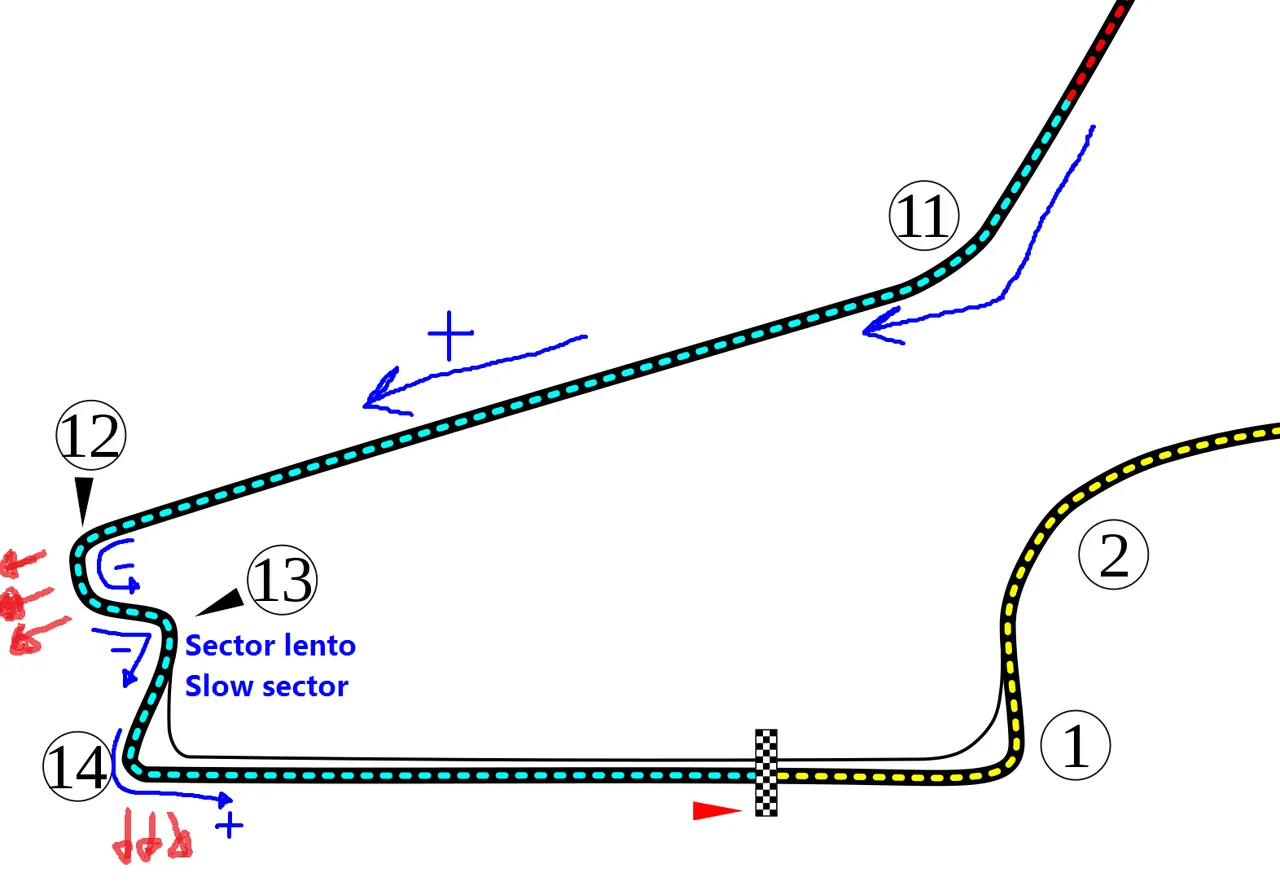
Las curvas 9 y 10 son una especie de "chicane" antes de entrar a la zona de aceleración a fondo, y son importantes para construir adelantamientos. La curva 11 se traza a fondo, pero destaca por su abrupto quiebre de la recta. A partir de aquí, el resto del circuito se resume en 2 partes: tener un motor potente para llegar a la curva 12 con alta velocidad, y tener una buena aerodinámica y agarre mecánico para trazar las últimas curvas de baja velocidad de forma efectiva.
En resumen, este circuito destaca por su combinación de curvones de alta velocidad y zonas lentas. Es un circuito moderno con cierta esencia de los circuitos clásicos, con ligeros cambios de nivel que también lo hacen interesante, especialmente en la curva 4.
En resumen, este circuito destaca por su combinación de curvones de alta velocidad y zonas lentas. Es un circuito moderno con cierta esencia de los circuitos clásicos, con ligeros cambios de nivel que también lo hacen interesante, especialmente en la curva 4.
Turns 9 and 10 are a kind of "chicane" before entering the full throttle zone, and are important for building overtaking. Turn 11 is traced at full throttle, but stands out for its abrupt break from the straight. From here, the rest of the circuit is summarized in 2 parts: having a powerful engine to reach turn 12 with high speed, and having good aerodynamics and mechanical grip to trace the last low speed corners effectively.
In summary, this circuit stands out for its combination of high speed corners and slow areas. It is a modern circuit with some essence of the classic circuits, with slight level changes that also make it interesting, especially in turn 4.
In summary, this circuit stands out for its combination of high speed corners and slow areas. It is a modern circuit with some essence of the classic circuits, with slight level changes that also make it interesting, especially in turn 4.
También te recomiendo visitar mi anterior publicación: Análisis del circuito de Sochi (Rusia)
I also recommend you to visit my previous post: Analysis of Sochi circuit (Russia)
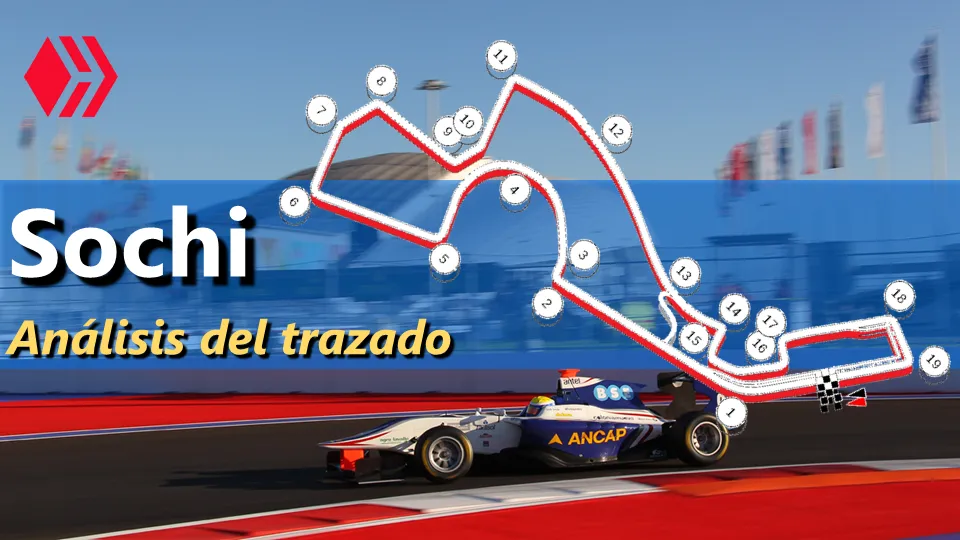
Deja tu comentario o comparte (reblog) esta publicación si te ha parecido interesante.
Leave a comment or share (reblog) this post if you found it interesting.
Translated to English language with the help of DeepL.com
| ¡Gracias por visitar! — Deja tu comentario 🚥🏆  |